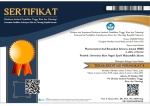Anti-Parkinson Drug from Chemical Medicines and Herbal Medicines: A Review
Abstract
Keywords
References
Arlina, P. and Evaria (eds) (2011) MIMS Indonesia Petunjuk Konsultasi. Media Data Indonesia.
Atwood, G. W., Hunnewell, L. G. and Saucier, R. M. (2005) Living well with Parkinson’s. 2nd editio. Hoboken, N.J.:John Wiley.
Baltuch, G. H. and Stern, M. B. (eds) (2007) Deep Brain Stimulation for Parkinson’s Disease. CRC Press.
Burn, D. J. (2007) ‘Predicting Dementia in Parkinson’s Disease: Clinical Risk Factors’, Neurodegenerative Disease, 4, p. 265.
Chen, W. et al. (2012) ‘Non-motor symptoms of Parkinson’s disease in China: A review of the literature’, Parkinsonism and Related Disorders, 18(5), pp. 446–452. doi: 10.1016/j.parkreldis.2012.02.002.
Cheng, Y. et al. (2008) ‘Neuroprotective effect of baicalein against MPTP neurotoxicity: Behavioral, biochemical and immunohistochemical profile’, Neuroscience Letters, 441(1), pp. 16–20. doi: 10.1016/j.neulet.2008.05.116.
Choi, J. G. et al. (2011) ‘Cistanches Herba enhances learning and memory by inducing nerve growth factor’, Behavioural Brain Research, 216(2), pp. 652–658. doi: 10.1016/j.bbr.2010.09.008.
Choi, J. G., Kim, H. G., et al. (2011) ‘Polygalae radix inhibits toxin-induced neuronal death in the Parkinson’s disease models’, Journal of Ethnopharmacology, 134(2), pp. 414–421. doi: 10.1016/j.jep.2010.12.030.
Colosimo, C., Riley, D. E. and Wenning, G. K. (2011) ‘Handbook of atypical parkinsonism’, pp. viii, 166 p.
Dushanova, J. (ed.) (2012) Mechanisms in Parkinson’s Disease – Models and Treatments. InTech.
Ebersbach, G. (2008) ‘Dopamine Agonists’, EPNN Journal, pp. 8–9.
Factor, S. A. and Weiner, W. J. (eds) (2008) Parkinson’s Disease: Diagnosis and Clinical Management. 2nd edn. Demos Medical Publishing.
Fernández-Mar, M. I. et al. (2012) ‘Bioactive compounds in wine: Resveratrol, hydroxytyrosol and melatonin: A review’, Food Chemistry, pp. 797–813. doi: 10.1016/j.foodchem.2011.08.023.
Fisher, A. et al. (eds) (2008) Advances in Alzheimer’s and Parkinson’s Disease: Insights, Progress, and Perspectives (Advances in Behavioral Biology). 2008th Edi. Springer.
Goldstein, N. (2008) Parkinson’s Disease (Genes & Disease). 1st Editio. Chelsea House Publishers.
Halliday, G., Barker, R. and Rowe, D. (eds) (2011) Non-dopamine Lesions in Parkinson’s Disease. Oxford University Press, Inc.
Van Kampen, J. et al. (2003) ‘Neuroprotective actions of the ginseng extract G115 in two rodent models of Parkinson’s disease’, Experimental Neurology, 184(1), pp. 521–529. doi: 10.1016/j.expneurol.2003.08.002.
Kim, B. W. et al. (2012) ‘Modulation of LPS-stimulated neuroinflammation in BV-2 microglia by Gastrodia elata: 4-Hydroxybenzyl alcohol is the bioactive candidate’, Journal of Ethnopharmacology, 139(2), pp. 549–557. doi: 10.1016/j.jep.2011.11.048.
Kim, H. J. et al. (2003) ‘Ethyl ether fraction of Gastrodia elata Blume protects amyloid β peptide-induced cell death’, Journal of Ethnopharmacology, 84(1), pp. 95–98. doi: 10.1016/S0378-8741(02)00290-8.
Kwon, S. H. et al. (2012) ‘Lonicera japonica THUNB. protects 6-hydroxydopamine-induced neurotoxicity by inhibiting activation of MAPKs, PI3K/Akt, and NF-κB in SH-SY5Y cells’, Food and Chemical Toxicology, 50(3–4), pp. 797–807. doi: 10.1016/j.fct.2011.12.026.
Levites, Y. et al. (2001) ‘Green tea polyphenol (-)-epigallocatechin-3-gallate prevents N-methyl-4-phenyl-1,2,3,6-tetrahydropyridine-induced dopaminergic neurodegeneration.’, Journal of neurochemistry, 78, pp. 1073–1082. doi: 10.1046/j.1471-4159.2001.00490.x.
Li, F. Q. et al. (2005) ‘Inhibition of microglial activation by the herbal flavonoid baicalein attenuates inflammation-mediated degeneration of dopaminergic neurons’, in Journal of Neural Transmission, pp. 331–347. doi: 10.1007/s00702-004-0213-0.
Li, X. Z. et al. (2013) ‘Recent advances in herbal medicines treating Parkinson’s disease’, Fitoterapia, pp. 273–285. doi: 10.1016/j.fitote.2012.12.009.
Liu, Z. et al. (2011) ‘Overexpression of a resveratrol synthase gene (PcRS) from Polygonum cuspidatum in transgenic Arabidopsis causes the accumulation of trans-piceid with antifungal activity’, Plant Cell Reports, 30(11), pp. 2027–2036. doi: 10.1007/s00299-011-1110-2.
Luo, F. C. et al. (2010) ‘Panaxatriol saponins extracted from Panax notoginseng induces thioredoxin-1 and prevents 1-methyl-4-phenylpyridinium ion-induced neurotoxicity’, Journal of Ethnopharmacology, 127(2), pp. 419–423. doi: 10.1016/j.jep.2009.10.023.
Luo, F. C. et al. (2011) ‘Protective effect of panaxatriol saponins extracted from Panax notoginseng against MPTP-induced neurotoxicity in vivo’, Journal of Ethnopharmacology, 133(2), pp. 448–453. doi: 10.1016/j.jep.2010.10.017.
Mandel, S. et al. (2004) ‘Erratum: Cell signaling pathways in the neuroprotective actions of the green tea polyphenol (-)-epigallocatechin-3-gallate: Implications for neurodegenerative diseases (Journal of Neurochemistry (2004) 86 (1555-1569))’, Journal of Neurochemistry, 89(2), p. 527. doi: 10.1111/j.1471-4159.2004.02503.x.
Mu, X. et al. (2009) ‘Baicalein exerts neuroprotective effects in 6-hydroxydopamine-induced experimental parkinsonism in vivo and in vitro’, Pharmacology Biochemistry and Behavior, 92(4), pp. 642–648. doi: 10.1016/j.pbb.2009.03.008.
Nutan, S. (2008) Parkinson’s Disease. Greenwood Press.
Park, J. S. et al. (2009) ‘Anti-inflammatory mechanism of ginseng saponins in activated microglia’, Journal of Neuroimmunology, 209(1–2), pp. 40–49. doi: 10.1016/j.jneuroim.2009.01.020.
Playford, D. (ed.) (2004) Neurological Rehabilitation of Parkinson’s Disease. 1st Editio. London: CRC Press.
Radad, K. et al. (2004) ‘Ginsenosides Rb1 and Rg1 effects on mesencephalic dopaminergic cells stressed with glutamate’, Brain Res, 1021(1), pp. 41–53. doi: S0006-8993(04)00962-X [pii] 10.1016/j.brainres.2004.06.030.
Rana, A. Q. (2011) Diagnosis and Treatment of Parkinson’s disease, Diagnosis and Treatment of Parkinson’s disease. doi: 10.5772/952.
Rausch, W. D. et al. (2006) ‘Neuroprotective effects of ginsenosides’, Acta Neurobiologiae Experimentalis, pp. 369–375.
Sharangi, A. B. (2009) ‘Medicinal and therapeutic potentialities of tea (Camellia sinensis L.) - A review’, Food Research International, pp. 529–535. doi: 10.1016/j.foodres.2009.01.007.
Silitonga, R. (2007) Tesis Faktor-Faktor yang Berhubungan dengan Kualitas Hidup Penderita Penyakit Parkinson di Poliklinik Saraf RS Dr Kariadi. Universitas Diponegoro.
Starkstein, S. E. and Merello, M. (eds) (2004) Psychiatric and Cognitive Disorders in Parkinson’s Disease. Cambridge University Press.
Stefanova, N. A. et al. (2011) ‘Effects of Cistanche deserticola on behavior and signs of cataract and retinopathy in senescence-accelerated OXYS rats’, Journal of Ethnopharmacology, 138(2), pp. 624–632. doi: 10.1016/j.jep.2011.10.017.
Tjay, T. H. and Rahardja, K. (2007) Obat-Obat Penting: Kasiat, Penggunaan dan Efek-Efek Sampingnya. PT Alex Media Komputindo.
DOI: 10.15408/pbsj.v3i1.20304
Refbacks
- There are currently no refbacks.






